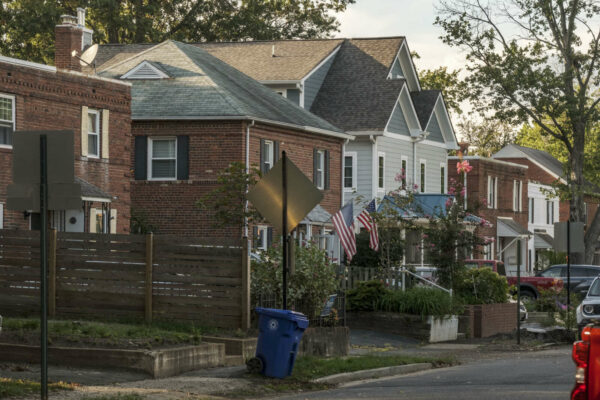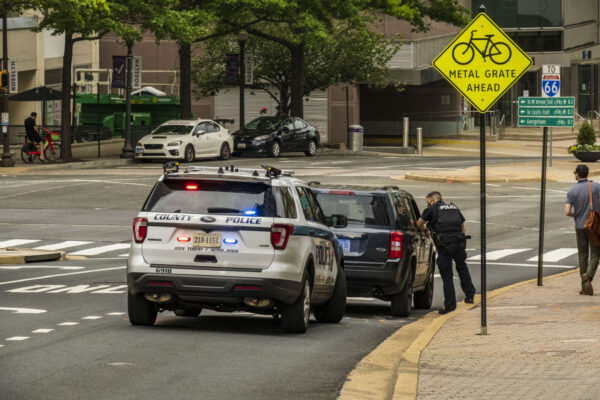The local NAACP is calling on the Arlington County Board to do more to encourage affordable homeownership opportunities for residents of color.
Although segregation officially ended last century, the Arlington branch of the NAACP says non-white residents are still effectively excluded from some neighborhoods due to county zoning codes, compounded by rising housing costs.
“The widespread single-family zoning scheme that prevents the construction of new housing in affluent, mostly white neighborhoods also worsens racial segregation by confining the construction of new affordable housing units to the Columbia Pike corridor and other parts of Arlington with large non-white populations,” the NAACP wrote in a letter to the county.
“People of color wishing to live in Arlington deserve meaningful opportunities to choose from a wide variety of housing types, in many parts of the county, at a reasonable cost,” the letter continues.
The NAACP says the county needs to adopt a comprehensive strategy to reform the county’s zoning laws and housing policies. It suggests reforms that go beyond those being considered in the Missing Middle Housing Study.
“We support the County’s many studies and other initiatives to promote affordable housing,” it concludes. “The best way to ensure the success of these initiatives is for the County Board and County Manager to show decisive leadership now and commit to supporting comprehensive zoning reform.”
Through Missing Middle, the county is considering whether and what kind of low-density multifamily housing could fit into single-family home neighborhoods. The county says allowing more housing types in these neighborhoods can reverse the lingering impacts of yesteryear’s racist zoning policies.
“The Missing Middle Housing Study has documented the role that Arlington’s land use and zoning policies have played in contributing to racial disparities in housing and access to opportunity,” says Erika Moore, a spokeswoman for the Department of Community Planning, Housing and Development. “Conducting the Missing Middle Housing Study is one of many deliberate choices the County is making to address the mistakes of the past and pave a new path for Arlington’s future.”
While supportive of the study, the NAACP suggests solutions beyond its parameters.
It recommends every redevelopment be assessed for whether it would perpetuate historical exclusion or displace the existing community. If so, developers would have to use a “displacement prevention and mitigation toolkit” to reverse those impacts.
This toolkit could include:
- property tax deferrals for lower-income homeowners
- funding for Community Land Trust acquisitions
- preferences for first-generation homebuyers
- stabilization funds for residents at risk of displacement
The toolkit would “address the unique needs of and the displacement risk experienced by the community in and around site-plan and by-right developments while also helping to address patterns of historical exclusion experienced by members of protected classes,” the letter says.
These and other tools should also receive county and state funding, like a quick-strike land acquisition account, which would be used to quickly purchase properties for affordable housing development, and targeted homeownership assistance programs, the NAACP says.
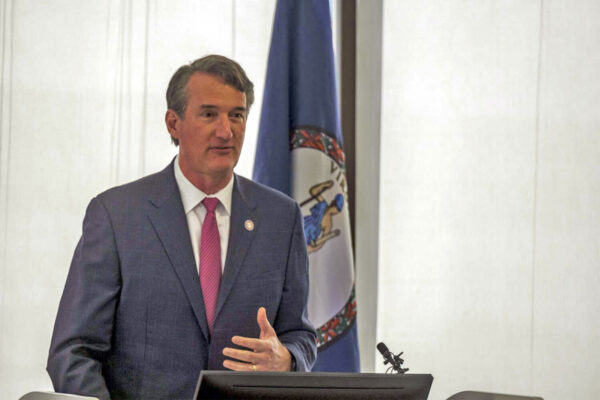
(Updated at 1:55 p.m.) Gov. Glenn Youngkin’s first veto could mean Arlington’s police oversight board cannot be led by an independent policing auditor.
Today (Tuesday), the Republican governor vetoed his first bill: HB 670, put forward by Arlington’s Del. Patrick Hope (D). It would have granted the Arlington County Board permission to appoint an independent auditor who would oversee the Community Oversight Board (COB), which is tasked with handling civilian complaints of misconduct by Arlington police officers.
Arlington County Board Chair Katie Cristol told ARLnow this morning that the Board wants to work with Youngkin to clarify the powers of the county’s police oversight board and the role of the auditor in hopes that he will rescind the veto.
The Arlington County Democratic Committee decried the veto as “play[ing] politics with a commonsense measure that passed the GOP controlled House.”
Vetoing Arlington
Despite passing with bipartisan support Governor Youngkin vetoed a bill from @HopeforVirginia that would have allowed an independent police auditor in Arlington
There is no reason to play politics with a commonsense measure that passed the GOP controlled House https://t.co/9TSNf4Tlpr
— Arlington Democrats (@arlingtondems) March 1, 2022
The policing auditor would have been a County Board-appointed position and the person filling the role would have answered directly to the Board. Most other top managerial positions report to the Board-appointed County Manager.
Should Youngkin’s veto remain in place, Cristol says the COB would still be led by an auditor, but this leader would instead answer to County Manager Mark Schwartz. That would mean a weaker auditor, she adds.
“It was really important that the independent policing auditor be just that, and not be under the chief law enforcement official of the county, which is the County Manager,” Cristol said.
Cristol says the Board wants to work with Youngkin because it seems — by his press release — that he misunderstands what the COB can and cannot do. She said the governor may have vetoed the bill based on a faulty understanding of the new body’s powers.
“Based on his press release, I think he made this action without full knowledge of what he was vetoing,” she said. “Specifically, he says, in referencing his vetoing of the bill, the Community Oversight Board would ‘make binding disciplinary determinations, including termination and involuntary restitution.’ Our ordinance didn’t empower the COB or the independent auditor to do that.”
Hope’s bill was merely an “administrative fix” to a bill passed last year, she said.
“Assuming this does stand, we are incredibly disappointed,” she said. “It’s not an expansion of [the] Community Oversight Board in the Commonwealth. It puts Arlington into parity with other jurisdictions in the Commonwealth.”
Del. Hope explains that his bill corrects for a shortcoming in the county charter that requires the County Board to get permission from the General Assembly to make any hire. He says Youngkin’s response is a new one.
“In my 13 years of service, I don’t ever recall seeing a Governor vetoing a local Charter bill,” he said. “To say that I’m disappointed the Governor would use his veto pen on a Charter bill to make a misguided political statement is an understatement.”
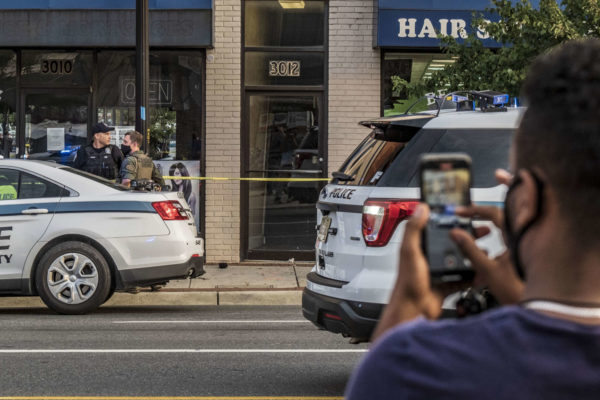
The County Board and the community have a small mountain of applications to Arlington’s new police oversight board to sift through.
Between October and December of last year, more than 100 people applied to sit on the county’s Community Oversight Board, according to Board Vice-Chair Christian Dorsey.
The County Board created the group last summer to receive complaints of police misconduct. Following the recommendations of the Police Practices Group — convened after 2020’s summer of nationwide racial justice protests — the Board endowed the COB with the power to subpoena for evidence or witnesses if the police department withholds them.
Now, the County Board and a panel of community members have the monumental task of winnowing down the 100 applicants to nine candidates — seven voting and two non-voting members — by mid-March.
“On behalf of all of us, I think we can say thank you, thank you for the tremendous outpouring of interest and support for this initiative in Arlington,” said Dorsey, who is a liaison to the COB along with Board member Matt de Ferranti.
A multi-step interview process is now underway, says Dorsey.
Candidates have been invited to participate in video interviews so they can be screened before they go before a panel, which will largely be composed of people who were engaged in the creation of the COB last year.
This panel will choose who will interview with the County Board.
Dorsey says the goal is to fully impanel the COB by the County Board’s March meeting.
“We are very, very thrilled that this is going to move forward,” he said. “We really thank so many Arlingtonians who are interested in transparency and accountability in law enforcement and working to build trust with our police department and community.”
Dorsey noted that he was pleased the applicant pool reflects Arlington’s diversity.
“This was very much a standard by which we want to establish our Community Oversight Board, and at least from the screening of the applicants thus far, we will absolutely be able to meet that important mandate,” he said.
The COB would be lead by an independent auditor-monitor who can conduct investigations concurrent with internal police department investigations. This position, however, is subject to approval by state legislature, possibly during the 2022 legislative session.
Del. Patrick Hope (D-47) is chief patron of House Bill 670 that would allow Arlington County to appoint the independent policing auditor.
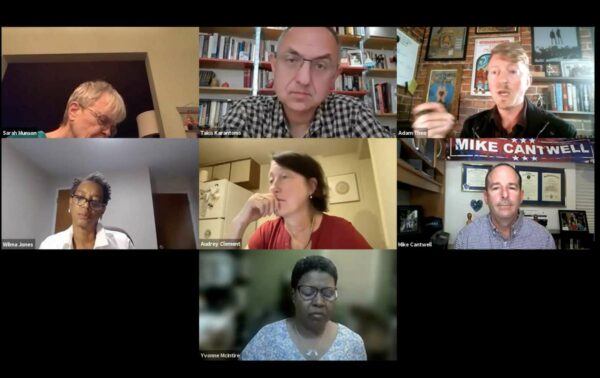
Local candidates offered differing takes on police oversight and demographic disparities in public schools during a candidate forum last night.
The Arlington branch of the NAACP hosted Monday’s forum, featuring the four Arlington County Board candidates — incumbent and Democrat Takis Karantonis and independents Mike Cantwell, Audrey Clement and Adam Theo — as well as School Board candidates Mary Kadera and former Congressional candidate Major Mike Webb.
More than 100 people were in virtual attendance.
The forum addressed two dozen issues facing the county and its communities of color. County Board topics ranged from support for minority-owned businesses to accountability for developers that neighbors say violate construction terms. Schools topics spanned the unequal distribution of Parent-Teacher Association resources to improving outcomes for students of color.
But the sharpest distinctions among County Board candidates came out during a discussion of the powers endowed to the new police oversight board.
This summer, the Arlington County Board established a Community Oversight Board (COB) with subpoena power and authorized the hiring of an Independent Policing Auditor able to investigate community complaints about police officers. The decision, came amid sharp disagreements over whether board had too much, or too little, authority.
“The overall perception from many of the members, [and] people I know who are not NAACP members… is that the board is aligned with interests that are not the ones that the community is telling you we want,” said moderator Wilma Jones Kilgo.
When asked if the COB aligns with their visions, only Karantonis said it did.
“It aligned mostly with [my] vision,” Karantonis said. “We now have to nominate the board, make it work, fund it and staff it.”
Cantwell said the board shouldn’t have subpoena power or investigatory power.
“Elections are where you should hold people accountable,” he said. “You should hold the current County Board, who appoints the County Manager and the police chief, accountable, and vote them out.”
But Theo and Clement said the Community Oversight Board isn’t independent enough.
“I’m glad we got the subpoena power, but it fails utterly with not being able to properly investigate and not being able to follow through with discipline,” Theo said. “It needs to be independent. Right now, it’s still under the County Manager, that isn’t enough.”
Clement, who supports giving the board subpoena power, nonetheless called it “a toothless tiger.”
“In situations where the oversight board exercises concurrent jurisdiction with the police department in a personnel matter, I believe COB should have binding authority, as the likelihood of the police chief honoring a recommendation of the COB that goes against his own decision is nil,” she said.
She also expressed concern that the County Manager, who hires the police chief, also hires the independent auditor.
Later, Karantonis said the County Board has put some pressure on the state to change the law that gives Arlington the power to hire a police auditor.
“It is a flaw that the County Manager formally chooses this person,” he said. “We have asked the General Assembly to change that and fix other flaws in this [provision].”
Meanwhile, Jones pressed Clement and Theo on other issues they raised related to policing and the criminal justice system.

The recently-renamed Langston Blvd is getting a larger-than-life mural of its namesake, Black abolitionist John M. Langston.
The public artwork commemorates the struggle for racial equality in Arlington and the renaming of Route 29, previously named for Confederate Gen. Robert E. Lee.
Work on the outdoor public art is set to finish within the next week and a half, Langston Boulevard Alliance executive director Ginger Brown said. The mural adorns a wall on the side of swimming store Sport Fair (5010 Langston Blvd), which was chosen for its location in the historically Black neighborhood of Hall’s Hill, as well as its visibility from the road.
The new name and mural pay tribute to Langston, who was Virginia’s first Black congressional representative and served as the first dean of Howard University’s law school and the first president of Virginia State University.
It will also incorporate the places and moments in Arlington’s history of racism and racial progress. The Langston Boulevard Alliance says it worked with the artist, D.C. native Kaliq Crosby, to include depictions of Arlington’s Freedman’s Village, established after the Civil War, the segregation of the Hall’s Hill neighborhood and the integration of public schools.
“There is a significant piece of the mural that… came [about] during the design process,” Brown said. “The historic John M. Langston School will be included in the mural. It is the school where all of the Hall’s Hill children went before the Stratford School was integrated.”
About a block from the mural, the elementary school for Black children operated until Arlington County closed it in 1966 as part of its desegregation plan. Today it is the Langston-Brown Community Center (2121 N. Culpeper Street), which also houses alternative high school programming.
A ribbon cutting for the mural, which was co-sponsored by Arlington Arts and Arlington Economic Development, is slated for later this week. Crosby has completed other racial justice and civil rights-themed murals in the D.C. area, including a recent mural of inaugural poet Amanda Gorman in Dupont Circle.
The Langston Boulevard Alliance will celebrate the renaming of the corridor next month with a pair of public events on Saturday, Oct. 2: a walking tour of Langston Blvd’s racial history and a fall festival at Woodstock Park featuring food, music and family-friendly activities.
There will also be an art gallery featuring the works of local Black artists at Dominion Lighting (5053 Langston Blvd) from Oct. 2-31.
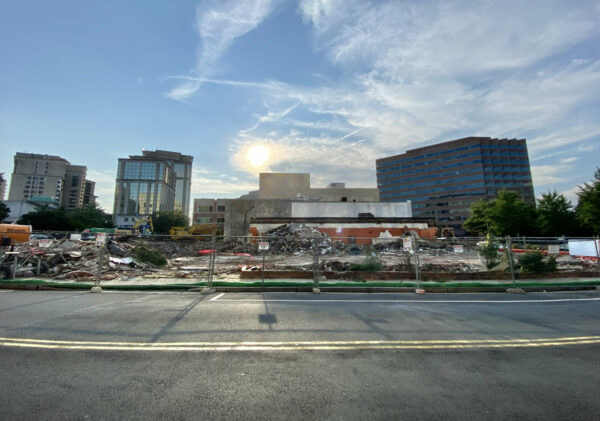
Pentagon City Metro Elevator Update — From Arlington Transit: “On Sun., Sept. 19, the bus stop serving ART 42, 74, 84 & 87, Metrobus 7A & 22A, and Fairfax Connector 599 (AM) will temporarily be relocated south on S Hayes St. due construction of Pentagon City Metro second elevator.” [Twitter]
Huffpost Calls Arlington GOP Tweet ‘Racist’ — “In a racist tweet Monday that was promptly ratioed into the shame museum, the Arlington County Republican Committee in Virginia suggested that two Democratic congresswomen of color should retire and go work as lobbyists for the Taliban… ‘This tweet isn’t about race ― it’s about the Squad’s constant support for anti-American sentiment abroad,’ the Arlington GOP tweeted.” [Huffpost]
ACFD Responds to Courthouse Gas Leak — “Arlington County Fire and Rescue crews said a gas leak reported just before 10 a.m. Wednesday in the Courthouse area was fixed about an hour later.” [Patch, Twitter]
Local Nurse Lauded for Covid Candor — “An Arlington woman who continues going above and beyond to help her community throughout the pandemic is being nominated for a community hero award from her fellow neighbors.” [WJLA]
Arlington Students Make ‘Merit’ Semis — “Sixteen high school students from Arlington have been named 2022 National Merit Scholarship semifinalists, taking the first step in securing a scholarship in the competitive program.” [Patch, Arlington Public Schools]
Restaurant Recs for Those With Kids — “Going out with kids is complicated enough — finding dishes for picky eaters, hoping they will sit still long enough to finish their food and not terrorize other tables, praying you can relax for five minutes… These restaurants are going out of their way to create a welcoming, inclusive and safe dining environment for families, with outdoor dining and child-pleasing choices.” [Arlington Magazine]

An Arlington County employee discovered “KKK” scrawled on a pillar in the parking garage below the county government’s Courthouse headquarters last week.
The employee, who is Black, found the message in the garage for the Ellen M. Bozman Government Center (2100 Clarendon Blvd) and reported the incident on Thursday morning to County Board members, County Manager Mark Schwartz, Chief Race and Equity Officer Samia Byrd and the Arlington branch of the NAACP, according to the local NAACP. The employee filed a police report yesterday (Monday).
The Arlington NAACP shared an excerpt from the email chain between the employee and the county that it said encapsulates how the incident harms more than just the individual who found it.
“It seems because I reported it, and because I happen to be Black, I am seen as a single victim,” the employee wrote to the county in an email, according to the NAACP. “I do not see myself in this way.”
In a statement to ARLnow, County Board Chair Matt de Ferranti condemned the message.
“It’s unfortunate and unacceptable to see racist graffiti anywhere in our community, let alone in our own parking garage,” de Ferranti said. “This garage is open to the public at all times and frequented by those using the businesses throughout the Courthouse neighborhood.”
Arlington’s Department of Environmental Services and property owner JBG Smith took steps to remove the writing from the pillar, he said.
“Our thanks go to the individual who reported it to us,” he added. “ACPD is also investigating, and we will have a more extensive response regarding the steps we have, are, and will be taking over the coming days.”
In a statement, the Arlington branch of the NAACP took a stronger stance, saying any county employee who parked in that garage was “victimized” by the message and emphasizing that this incident is not “graffiti.”
“Speech expressing hatred of a particular group of people is defined as ‘hate speech’ and is not ‘graffiti,'” the organization said. “The Arlington Branch NAACP condemns any form of hate speech and stands with the Black employees and any employee or citizen who reports hate speech.”
The NAACP asked county leadership to send a message to the county workforce that hate speech will not be tolerated anywhere.
“However, sadly, the County missed the opportunities to get in front of this and, as of Monday evening, four days later, still had not addressed these concerns with its employees,” it said.
Hateful messages have popped up elsewhere in Arlington in recent years.
“It’s OK to be white” was sprayed over a church’s racial justice sign last summer. “Heil Trump,” “KKK” and two swastikas were found on a dumpster two years ago — the same year racial and gender slurs were found on a building that serves people with developmental delays.
The full statement from the NAACP is below.
Arlington County will now have a Community Oversight Board and Independent Policing Auditor able to investigate community complaints about police officers.
During a four hour meeting last night (Wednesday), 24 leaders and community members spoke, ranging from Arlington NAACP leadership to police officers. The County Board overcame some disagreements to unanimously approve a new board that takes complaints and has an independent auditor to conduct investigations concurrent with internal police department investigations.
If necessary, the board can subpoena for evidence or witnesses if the department withholds them.
These were powers recommended by the Police Practices Work Group, convened one year ago after the killing of George Floyd at the hands of police in part to imagine what a review board could look like. And proponents said that subpoena power — the most hotly contested authority last night — is the sole key to a fully independent board.
“The subpoena power is integral to the independence of the Community Oversight Board,” County Board Vice-Chair Katie Cristol said. “Otherwise, the community oversight is just another step in the ACPD chain of command.”
On Twitter, she further explained the actions taken last night.
The PPG recommended empowering a Community Oversight Board & designating a professional auditor to investigate on their behalf, concurrently w/ but independent of ACPD's internal investigations. We adopted their model! Incl. subpoena power, to ensure a strong & independent COB.
— Katie Cristol (@kcristol) July 22, 2021
Above all: We adopt this strong COB proactively. No accident that Arlington hasn't had misconduct headlines: Officers' own zero tolerance for misconduct is the bedrock of our trustworthy PD. The COB brings community into this high standard of accountability & adds transparency.
— Katie Cristol (@kcristol) July 22, 2021
Board Member Libby Garvey, who ultimately voted in favor of the ordinance, did express some reservations with the power.
“Right now, the County Board has the right to subpoena… It’s one of our jobs,” she said. “I feel it’s unfair to put that on resident volunteers, as well-trained and well-meaning as they might be.”
Steve Yanda, the treasurer of Arlington Coalition of Police, said the group supports a review board but not the subpoena power, given how closely ACPD officers watch themselves.
The last three years of investigations by ACPD’s Office of Professional Responsibility (OPR) led to 639 suspension hours and to 11 officers leaving the department, he said. ACPD-originated complaints led to 53% of the suspension hours and 45% of the officer departures.
“It flies in face of logic to believe that a department that scrutinizes itself to the degree that the ACPD does, needs to also be monitored under threat of subpoena power by the community it serves,” he said.
And that OPR investigative process can be “mentally and physically exhausting and nerve-wracking,” said officer Tracey Bates.
“Adding on any additional pressures to an already thorough, exhausting process will lead to more highly qualified officers leaving the department, and with that comes the decline in officers, a decline in quality of services, and a decline in community engagement,” he said.
NAACP President Julius “J.D.” Spain said the board cannot privilege the voices of a few worried about police morale over the voices of community members advocating for a powerful, independent board, as recommended by the Police Practices Workgroup.
“The time has come in this country, in this Commonwealth, to stop rearranging furniture and start rebuilding the house, with transparency and accountability,” he said.
In a letter to the County Board earlier this year, public defender Brad Haywood said the PPG’s recommendations “give that oversight body the power it needs to solve the problems it identifies; to obtain the information, to conduct thorough investigations, and to make recommendations not just for how individual officers can do better, but how the Department and the County more broadly can do better.”
Even with these broad authorities, County Board members said the work is just beginning.
“We have to set in place an opportunity here for the community to figure out if our police department is to be trusted, if they don’t believe so already, and vice versa: for the police department to trust that the oversight being instituted today is designed not to get them, but to improve our overall approach to policing,” said Christian Dorsey.
A new timeline from Arlington County tracks how local policy decisions in the 20th Century disadvantaged people of color, particularly Black residents.
The county has released two timelines, spanning 1930-45 and 1946-60, which recount how policies and projects — touching on housing, education, transportation, planning and infrastructure — segregated Arlington. It also chronicles how Black residents responded by investing in their communities, getting into local government, protesting and going to the courts.
“This timeline will allow us to take inventory of who we are, where we have been, and how we are growing and evolving as we normalize, organize and operationalize racial equity,” said Arlington’s Chief Race and Equity Officer Samia Byrd. “It will help ground us in facts, communicate the importance of why we lead with race in addressing systemic inequities as a government, and remind our community that racism is real and why it matters.”
Once complete, the historical resource will span from the early 1600s to present day. For now, here are some of the important events that the county included from 1930-45:
- 1930s: The Hall’s Hill “Segregation Wall,” separating the majority-white neighborhood of Woodlawn and the majority-Black neighborhood, goes up.
- 1931-32: Route 50 is built and the streetcars between Washington D.C. and Mount Vernon are shut down, cementing the county’s racial divides.
- 1932: Hoffman-Boston Junior High School opened and would later become a high school. Up until this point, Black students’ education ended after primary school.
- 1932: After switching from an appointed County Board to an elected one, Dr. Edward T. Morton, the county’s first Black physician, became one of the first Black Arlingtonians to run for office. (It took 55 years for a Black candidate to win a County Board election.)
- 1940s: Pentagon construction displaced 225 African-American families, or 810 people. They were relocated to two trailer camps near Columbia Pike and in Green Valley.
- 1943: Without public transit, and with lower rates of car ownership, Black residents founded Friendly Cab in Green Valley and Crown Cab in Hall’s Hill to connect their communities to the region.
While Arlington recently honored the story of four students who desegregated Stratford Junior High School in 1959, the road to desegregating schools, mired in lawsuits and bureaucracy, began more than a decade prior and continued after their first day.
From 1946-60, here are some significant moments related to the struggle for an equal, integrated Arlington:
- 1946: D.C. ruled that Arlington students attending D.C. schools would have to pay tuition. Many Black Arlingtonians sent their kids to D.C. schools because they had more resources than the county’s segregated public schools.
- 1947: Constance Carter sued the Arlington School Board because facilities at the all-Black Hoffman-Boston High School were unequal to those at the all-white Washington-Lee High School.
- 1950: A federal judge reversed the district court’s ruling in favor of the School Board. The county was forced to invest in segregated Black schools and Black teachers were given the same salary as white instructors.
- 1951: Fire Station 8, the all Black-volunteer fire station that served Black communities, received its first county-paid firefighter — 10 years after the other stations.
- 1953: The Veteran’s Memorial YMCA pool opened, serving “non-white” residents barred from other county facilities. The county opened its first integrated community center at Lubber Run Park in 1956.
- 1960: A sit-in at the People’s Drug Store in Cherrydale protesting segregated lunch counters kicked off a month of sit-ins. Woolworth’s store in Shirlington was the first to announce it was desegregating; 21 lunch counters followed suit.
The county will host a discussion next Wednesday (July 21) via Facebook Live at 7 p.m. called “Race Matters: Anticipating our Future, Examining our Past.”

The swim and dive teams at the Dominion Hills Pool are ditching the “Warriors” team name and moving away from Native American motifs.
The Dominion Hills Area Recreation Association Board of Directors started soliciting suggestions from swimmers, divers, coaches and families on Friday, according to an email to team families, shared with ARLnow.
“We decided to stop using Native American imagery at our pool and the name ‘Warriors’ for our swim and dive teams,” the board tells ARLnow in a statement. “While the name ‘Warriors’ has several meanings and by itself is unobjectionable, the teams have used it in connection with Native American themes. The Board decided to solicit ideas from the members for a new name and mascot.”
It started de-emphasizing the use of the name this season, according to an email to team families. The pool’s board is open to a name that would permit members to use existing gear, which bears a feather illustration.
“We recognize that there may be some disappointment as we make this transition but we are excited to select a new team name and mascot,” the email said. “Team names that would be appropriate to use with a feather mascot have the added practical benefit of allowing us to continue using the feather on existing team gear.”
A committee of team representatives and board members will review the submissions and recommend a new name to the full board, which aims to announce the new name at a banquet on Saturday, July 24, according to the email.
The Washington Football Team — which nixed its former name one year ago — is making a similar play as it narrows down options for a new name and logo, to be chosen early next year.
“Feedback from across communities we engaged clearly revealed deep-seated discomfort around Warriors, with the clear acknowledgment that it too closely aligns with Native American themes,” WFT president Jason Wright explained in a blog post.
A new installation outside Dorothy Hamm Middle School tells the story of the four students who integrated the building, formerly Stratford Junior High School, six decades ago.
Four free-standing panels and a wall-mounted panel, connected by a trail, depict Gloria Thompson, Ronald Deskins, Lance Newman and Michael Jones — the four students who desegregated the building on Feb. 2, 1959 — as well as Dorothy Hamm, the new school’s namesake and prominent civil rights activist in Arlington, and Barbara Johns, who at 16 led a student strike for equal education at a high school in Farmville, Virginia.
During a dedication ceremony for the new Stratford Commemorative Trail on Friday, several speakers said the installation equally inspires children to achieve greatness and charges Arlington Public Schools to continue making history.
“Rest assured that every child will leave this school knowing the civil rights history that happened here, understanding that while four students did begin the desegregation process in 1959, many others were denied that opportunity, and it came later,” school Principal Ellen Smith said. “Our students must know that as citizens of our school, our county, our state and our nation, they have the responsibility to speak up, to say something and make good trouble, as [former Rep.] John Lewis so aptly stated.”
The panels challenge those who walk the trail to take action and remind middle schoolers can make a difference at their age, she added.
APS & @ArlingtonVA dedicate the Stratford Commemorative Trail @DHMiddleAPS (formerly Stratford Jr High). The trail’s interpretive panels discuss nat’l, state & local history of school desegregation & honor the 4 students who desegregated Stratford on Feb. 2, 1959, & Dorothy Hamm. pic.twitter.com/IZRntPiQ01
— Arlington Public Schools (@APSVirginia) June 11, 2021
In 2016, the school was designated a local historic district and APS convened a committee to find a way to honor its history. Soon after, APS embarked on a process to convert the school at 4100 Vacation Lane from a building housing the H-B Woodlawn and Stratford programs to a neighborhood middle school. It was renamed for Hamm and reopened to students in 2019. Final touches were finished during the 2020-21 school year.


